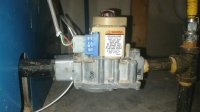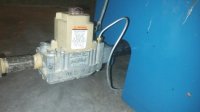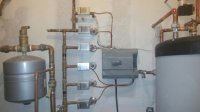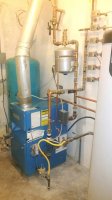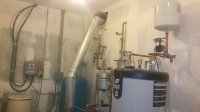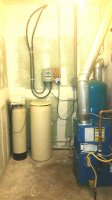amkazen
New Member
Hi,
I am looking for some guidance on my 15-year old Crown XBF-150EID LP boiler. Should we replace the gas valve only, the gas valve & aquastat, or just live with the two items right now, not replacing them, and replace the boiler before the Fall with a wall-hung high-efficiency unit? What would you do? We have a phenomenal plumber now and trust him 100% but I always like to have some sort of comprehension on a subject before making a decision, and right now I am confused.
Here is a list of the components in this combination radiant in-floor and domestic hot water system, installed in Spring of 2002.
Crown XBF-150EID LP boiler
Honeywell Aquastat Relay type L8148E
Honeywell VR8204A 2241 gas valve
TriangleTube 60-gallon indirect hot water tank - installed January 2016 - 1 year ago
Issue: In early December 2016, boiler did not heat water and I discovered soot had fallen around pilot light area, probably blocking the pilot from igniting. As soon as I cleaned the igniter, the pilot came on and we had hot water soon thereafter. This has happened about 4 times since, and even when it has not, the area under the igniter is often covered with soot.
Resolution: 2 days ago the plumber was out and took the sides completely off the boiler and cleaned everything. He said the burner tubes were clogged with dust and lint, a mouse was living in there (not sure where in a boiler it could live), and that the gas pressure was half of what it should be. The next day his troubleshooting told him the propane regulator is ok but that the boiler gas valve is not allowing enough pressure to meet manufacturer specs, and recommends replacing it.
Compounding factor: Plumber states floor heat requires 120*, water heater needs 160*, and boilers lowest temperature setting is 180*, and that equates to a lot of gas being wasted. This is the system that was installed in 2002 when the house was built and was what I was told was needed. He states the choices are: going to a wall-mounted IBC boiler before next fall, or changing the gas valve and aquastat (now also the aquastat, vs. just the gas valve?) He also states we can get by with it as is as it has been running this way since new, just very inefficient.
Confusion:
1) 1st, the gas valve needs to be replaced, but now it looks like the gas valve and the aquastat both should be replaced simultaneously. Can only the gas valve be replaced or is it better practice to always replace both at the same time?
2) Since it is running inefficiently from installation in 2002, and since the temps above indicate the boiler heats the water higher than what the floor and water tank require, I immediately jump to the conclusion I was sold the wrong system in 2002
a. Plumbers reply is that Crown boilers are a quality product and that it is the installer’s responsibility to adjust temp and gas pressure upon installation
b. He also stated he did not know if gas valve went bad or was set-up incorrectly
3) I am confused in that is the gas valve adjustable? Hmmmmm…..I just read the gas valve might need to be converted from natural gas to LP by the use of a flange….I wonder if the gas valve is not set-up for LP and is why the gas pressure is low…for 15 years? Would it even work ? Well, it has but still…..
Looking on-line I see the gas valve ranges from $109 to $150 (Robert Shaw 720-079) to $233 (WRD 36H32-304). The aquastat ranges from $170 - $300. I am guessing the cost replace these two items would be $400 in parts plus labor and I am unsure how many hours of labor....4 hours, to include adjusting, setting, etc? So, using $80 per hour as a rate that would be $320 plus $400 plus tax so I am looking at $800 or so, vs. living with it and replacing the boiler before next Fall.
What are your thoughts?
I am looking for some guidance on my 15-year old Crown XBF-150EID LP boiler. Should we replace the gas valve only, the gas valve & aquastat, or just live with the two items right now, not replacing them, and replace the boiler before the Fall with a wall-hung high-efficiency unit? What would you do? We have a phenomenal plumber now and trust him 100% but I always like to have some sort of comprehension on a subject before making a decision, and right now I am confused.
Here is a list of the components in this combination radiant in-floor and domestic hot water system, installed in Spring of 2002.
Crown XBF-150EID LP boiler
Honeywell Aquastat Relay type L8148E
Honeywell VR8204A 2241 gas valve
TriangleTube 60-gallon indirect hot water tank - installed January 2016 - 1 year ago
Issue: In early December 2016, boiler did not heat water and I discovered soot had fallen around pilot light area, probably blocking the pilot from igniting. As soon as I cleaned the igniter, the pilot came on and we had hot water soon thereafter. This has happened about 4 times since, and even when it has not, the area under the igniter is often covered with soot.
Resolution: 2 days ago the plumber was out and took the sides completely off the boiler and cleaned everything. He said the burner tubes were clogged with dust and lint, a mouse was living in there (not sure where in a boiler it could live), and that the gas pressure was half of what it should be. The next day his troubleshooting told him the propane regulator is ok but that the boiler gas valve is not allowing enough pressure to meet manufacturer specs, and recommends replacing it.
Compounding factor: Plumber states floor heat requires 120*, water heater needs 160*, and boilers lowest temperature setting is 180*, and that equates to a lot of gas being wasted. This is the system that was installed in 2002 when the house was built and was what I was told was needed. He states the choices are: going to a wall-mounted IBC boiler before next fall, or changing the gas valve and aquastat (now also the aquastat, vs. just the gas valve?) He also states we can get by with it as is as it has been running this way since new, just very inefficient.
Confusion:
1) 1st, the gas valve needs to be replaced, but now it looks like the gas valve and the aquastat both should be replaced simultaneously. Can only the gas valve be replaced or is it better practice to always replace both at the same time?
2) Since it is running inefficiently from installation in 2002, and since the temps above indicate the boiler heats the water higher than what the floor and water tank require, I immediately jump to the conclusion I was sold the wrong system in 2002
a. Plumbers reply is that Crown boilers are a quality product and that it is the installer’s responsibility to adjust temp and gas pressure upon installation
b. He also stated he did not know if gas valve went bad or was set-up incorrectly
3) I am confused in that is the gas valve adjustable? Hmmmmm…..I just read the gas valve might need to be converted from natural gas to LP by the use of a flange….I wonder if the gas valve is not set-up for LP and is why the gas pressure is low…for 15 years? Would it even work ? Well, it has but still…..
Looking on-line I see the gas valve ranges from $109 to $150 (Robert Shaw 720-079) to $233 (WRD 36H32-304). The aquastat ranges from $170 - $300. I am guessing the cost replace these two items would be $400 in parts plus labor and I am unsure how many hours of labor....4 hours, to include adjusting, setting, etc? So, using $80 per hour as a rate that would be $320 plus $400 plus tax so I am looking at $800 or so, vs. living with it and replacing the boiler before next Fall.
What are your thoughts?

